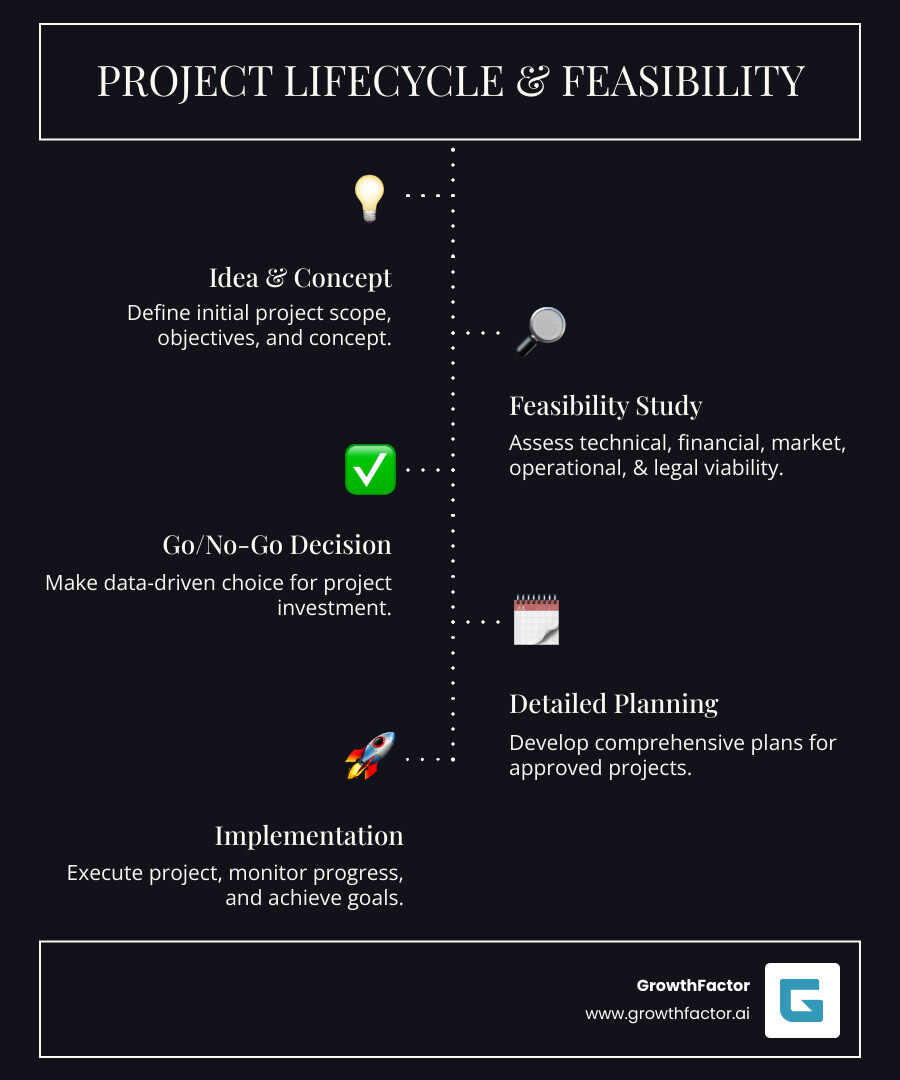Is Your Project Doomed? How to Conduct a Feasibility Study
Why Project Success Depends on Strategic Foresight
Project feasibility determines if an initiative can succeed before you invest significant time and resources. It involves evaluating five key areas: technical, financial, market, operational, and legal feasibility.
A sobering reality is that most projects fail due to preventable issues like scope creep, insufficient funding, or unrealistic deadlines. A proper feasibility study acts as an insurance policy against these costly mistakes, shifting decisions from gut feelings to data-driven analysis. As one project management expert notes, "A feasibility study points a project in the right direction by helping decision-makers gain a holistic view of potential benefits, disadvantages, barriers, and constraints."
Businesses often launch expensive projects without the due diligence they'd apply to building a house or opening a restaurant. Yet, conducting a thorough feasibility study doesn't have to be overwhelming. With the right framework, you can systematically evaluate your project's viability and make confident go/no-go decisions.
I'm Clyde Christian Anderson, CEO of GrowthFactor.ai, and I've spent over a decade evaluating project feasibility in retail real estate—from analyzing 15,000+ potential store locations to helping clients generate millions in revenue through data-driven site selection. In this guide, I'll share the exact process we use to turn risky ventures into calculated successes.

Basic project feasibility terms:
First Things First: What is a Feasibility Study and Why Does It Matter?
A project feasibility study is a comprehensive assessment that puts an idea through a rigorous reality test. It examines a project from every angle to determine if it's worth pursuing before you commit significant resources. The study objectively evaluates a venture's strengths and weaknesses, identifies market opportunities and threats, and outlines the resources needed for success.
This analysis provides a 360-degree view of your project, helping you spot potential roadblocks before they become expensive problems. For example, a study might uncover planned city construction that would block access to a new retail location, saving you from a costly lease. Furthermore, a well-researched feasibility report demonstrates professionalism to banks and investors, significantly increasing your chances of securing financing.

The Core Purpose: From Vague Idea to Viable Plan
A feasibility study transforms a fuzzy concept into a concrete, actionable plan or confirms that an idea is not viable, saving you from a costly mistake. It uncovers hidden strengths and weaknesses, such as having a brilliant technical team but lacking the operational bandwidth to handle the new workload. By evaluating real-world practicality, it considers regulatory problems, supply chain issues, and resource limitations. It enables data-driven decision making, replacing hope with solid evidence and creating a strategic foundation for all subsequent project planning.
When is a Study Necessary (and When Is It Not?)
While not every project needs a full feasibility study, the level of risk and investment determines the necessity. A study is crucial for:
- Large capital investments: For construction, new retail complexes, or major product lines, you must validate every assumption, from material costs to market variables.
- New product lines or market expansion: Before committing resources to untested ventures, you need to validate demand, production capabilities, and profitability, especially when entering new geographic markets.
- Complex or innovative ventures: The more interdependent and uncertain a project's components are, the more critical it is to understand how they will function together.
- Attracting investors or securing loans: External funders require a detailed report to assess risk and potential return.
Conversely, a full study may be unnecessary for small internal projects, routine upgrades, or repeat projects with known outcomes where variables have not changed significantly. The key is to match the depth of your analysis to the scope of your risk.
The 5 Lenses of Viability: Key Types of Feasibility Analysis
To evaluate project feasibility comprehensively, we must look through five interconnected lenses. A project might be technically brilliant but financially unviable, or legally compliant but operationally impossible. A holistic view is essential, as a failure in one area can jeopardize the entire initiative.

Technical Feasibility (The "Can We Build It?" Test)
Technical feasibility assesses if you have the resources to make the project happen. This includes not just the required technology (hardware, software, infrastructure) but also the technical expertise of your team. A project can fail if the team lacks the skills to use the available tools, a key consideration when implementing sophisticated platforms for Data-Driven Site Selection. Key questions also involve scalability (can the solution grow?) and system integration (will it work with existing systems?).
Financial/Economic Feasibility (The "Is It Worth It?" Test)
Financial feasibility determines if the project makes economic sense. This starts with a cost-benefit analysis, factoring in both obvious and hidden costs. Key metrics like Return on Investment (ROI), Net Present Value (NPV), and the payback period provide a reality check on profitability. You must also consider funding sources (cash flow, loans, investors) and their implications. For retail locations, accurate financial modeling using Real Estate Data Insights is critical for projecting cash flow and operational costs.
Market Feasibility (The "Will They Buy It?" Test)
A project is only successful if customers want it. Market feasibility evaluates market demand: will enough people pay for your product or service? This involves competitor analysis to understand the landscape and target audience demographics to identify your customers. For retail, geographic influence is paramount, as local dynamics can make or break a location. Our Market Area and Retail Location Analysis tools help assess these factors. Finally, a viable pricing strategy must align with customer willingness to pay and business profitability.
Operational Feasibility (The "Can We Run It?" Test)
Operational feasibility examines if your organization can execute and sustain the project. This includes resource availability (people, equipment, bandwidth) and staffing and human capital (hiring, training). It's also crucial to assess workflow integration to ensure the new project meshes with existing processes without causing chaos. The project must have a clear alignment with business objectives to support the company's strategic direction. A successful Site Selection Strategy must account for these operational realities.
Legal & Scheduling Feasibility (The "Are We Allowed & On Time?" Test)
These final checks prevent costly surprises. Legal feasibility covers compliance with zoning laws, permits and licenses, data protection acts (like GDPR or CCPA), and contractual obligations. Scheduling feasibility assesses project timeline realism, considering team commitments, vendor availability, and seasonal factors. Missing key deadlines, like a holiday shopping season, or facing resource scheduling conflicts can derail an otherwise viable project. These lenses ensure your project is not just a great idea, but one that can actually be realized.
Your 6-Step Guide to Conducting a Thorough Project Feasibility Study
A project feasibility study is a standalone "enabling project" that requires its own timeline and resources to ensure objective results. The project manager acts as a facilitator, gathering information and ensuring the analysis is honest and thorough. This six-step process transforms uncertainty into confidence.
Step 1: Conduct a Preliminary Analysis
This initial screening filters out clearly unworkable ideas. Start by identifying obvious roadblocks, such as a required permit being unavailable in a target area. Conduct stakeholder interviews with customers, team members, and investors to uncover blind spots. Finally, define your project scope and boundaries to prevent scope creep later. This early work is key to Understanding the Scope of Your Project Feasibility.
Step 2: Assess Financial Projections
This step determines if the numbers work. Create a projected income statement with conservative revenue estimates. Perform a detailed cost estimation, separating one-time capital expenditures from recurring operational costs. A cash flow analysis ensures you can meet obligations, while a break-even analysis identifies the sales volume needed to become profitable. For complex retail projects, our expertise in The Financial Side of Project Feasibility helps build accurate financial models.
Step 3: Perform a Market Assessment
This step confirms that real customers want what you're offering. Use market research surveys to gauge buying intent and pricing sensitivity. A competitor SWOT analysis maps the competitive landscape and reveals opportunities. The goal is market opportunity identification—finding the underserved gap where your project can thrive. Our platform helps clients master Automated Market Analysis Best Practices to turn guesswork into market certainty.
Step 4: Plan for Technical and Operational Needs
Here, you plan the "how." Resource planning involves inventorying the people, skills, equipment, and materials needed. A technology stack evaluation ensures all technical components are compatible and integrate with existing systems. Organizational planning defines roles, responsibilities, and reporting structures. For physical products or retail, logistics and supply chain considerations are critical. This detailed planning is the core of a successful Real Estate Feasibility Study.
Step 5: Review Vulnerabilities and Create Contingencies
Every project has risks; this step is about managing them proactively. Use a risk assessment matrix to categorize potential problems by likelihood and impact. Identify Points of Vulnerability (POVs)—internal single points of failure, like reliance on one key employee or supplier. Develop contingency plans for high-impact risks, answering the "what if" questions before they become crises. Major infrastructure projects like the Ultra-High-Speed Rail Study demonstrate this principle of anticipating problems.
Step 6: Make the Go/No-Go Decision & Report
This is the final decision point. Compile all findings into a coherent, unbiased report. Write a concise executive summary that leads with your recommendation and key supporting data. Provide clear recommendations based on the evidence, whether it's to proceed, modify, or shelve the project. Finally, hold a stakeholder presentation to discuss the findings and gain collective buy-in. For complex ventures, applying Principles for novel and complex projects can help steer uncertainty in the decision-making process.
Feasibility Study vs. Business Case vs. Business Plan: Clearing the Confusion
It's common to confuse a feasibility study, business case, and business plan, but they serve unique, sequential purposes in the project feasibility and development process. Each document answers a different fundamental question:
- A Feasibility Study asks, "Can we do this?" It's an early-stage, objective assessment to determine if a project is viable before significant investment.
- A Business Case asks, "Should we do this?" Following a positive feasibility study, it justifies the project's strategic value and alignment with business goals to secure funding and approval.
- A Business Plan asks, "How will we run this business?" It's a comprehensive document outlining the entire operational and strategic plan for a new or ongoing venture.
A fourth document, the Project Charter, formally authorizes the project after approval and grants the project manager authority to use organizational resources.
This table summarizes the key differences:
| Feature | Feasibility Study | Business Case | Business Plan | Project Charter |
|---|---|---|---|---|
| Primary Purpose | Determine if project is viable (go/no-go decision) | Justify why project is worth doing | Outline overall business strategy and operations | Formally authorize project and define authority |
| Timing | Early lifecycle, before significant investment | After feasibility, before detailed planning | For ongoing/new ventures after validation | At initiation phase, once project approved |
| Audience | Internal stakeholders, decision-makers, investors | Senior management, sponsors, funding committees | Investors, lenders, partners, management | Project sponsor, stakeholders, project team |
| Key Question | "Can we do this successfully?" | "Is this the best way to achieve our goals?" | "How will this business operate?" | "What is this project and who's involved?" |
Understanding this progression is vital. The feasibility study provides the data for a compelling business case, which in turn leads to an approved project charter. For retail real estate, a feasibility study might validate a location's traffic, while the business case argues how that site fits the company's expansion strategy.
Frequently Asked Questions about Project Feasibility
Who should conduct a feasibility study?
The decision balances internal knowledge with external objectivity.
- Internal teams (like a PMO or subject matter experts) offer deep institutional knowledge of your company's culture, systems, and constraints.
- External consultants provide crucial objectivity, as they are not emotionally invested in the project's outcome. This is vital for high-stakes projects or when presenting to investors.
A hybrid approach is often best, combining internal context with specialized, unbiased external analysis.
How long does a feasibility study take?
The duration varies from a few weeks to several months, depending on:
- Project Complexity: A simple internal process review is faster than a multi-market retail expansion.
- Scope: Analyzing one location is quicker than analyzing fifty.
- Data Availability: The need for primary research (surveys, interviews) will extend the timeline compared to using existing data.
- Allocated Resources: A dedicated, full-time team will complete the study faster.
While it's a time investment, it's far less costly than pursuing a project that is doomed from the start.
What is the role of a project manager in a feasibility study?
During a project feasibility study, the project manager acts as a servant leader and facilitator, not a traditional manager. Their primary responsibilities are to:
- Facilitate discussions among stakeholders and experts to ensure all areas are covered.
- Oversee data gathering to ensure accurate and comprehensive information is collected.
- Manage stakeholder communication, keeping everyone informed and managing expectations.
- Ensure objectivity by preventing personal biases from influencing the study's conclusions.
- Coordinate resources for the study itself, including the team, budget, and timeline.
Conclusion: Paving the Way for Project Success
A project feasibility study is more than a checklist item; it's a strategic tool for turning risky ventures into calculated successes. It provides honest answers to critical questions about a project's viability before you commit significant resources.
By using the five key lenses (technical, financial, market, operational, legal) and following the six-step process, you create a comprehensive roadmap that identifies potential problems early. This systematic approach replaces hope with data-backed confidence, allowing you to present your project with conviction.
At GrowthFactor, we apply this principle daily. Our AI-improved platform transforms the guesswork of retail site selection into a strategic advantage, helping clients avoid costly mistakes and identify opportunities others miss. By investing time upfront to understand what's truly feasible, you save months of headaches and prevent significant financial losses.
Ready to turn your next retail expansion into a calculated success? Our expert-backed site evaluation services combine the rigor of traditional feasibility studies with the power of modern data analytics, giving you the confidence to make your next move with precision.
Citations
The human algorithm
Request Your demo
Schedule meeting
Or submit your information below and we'll be in touch to schedule.




